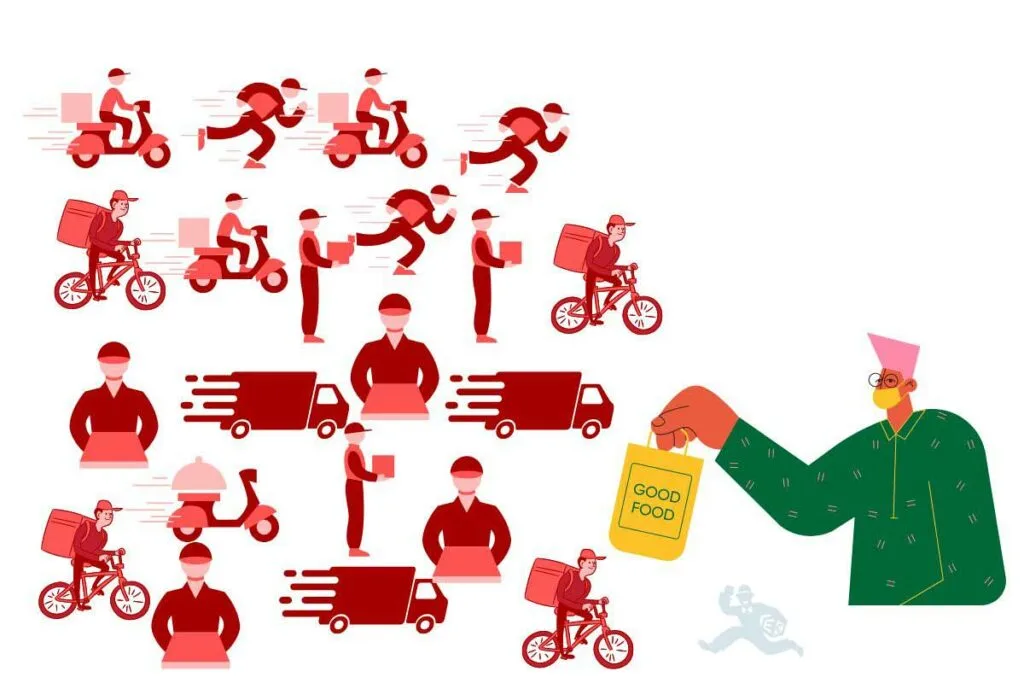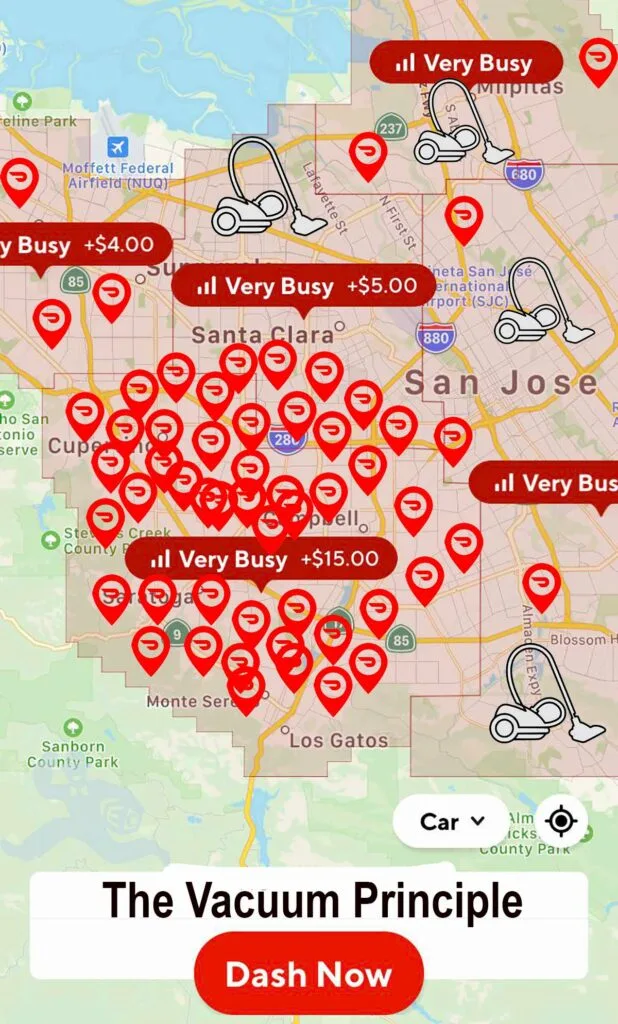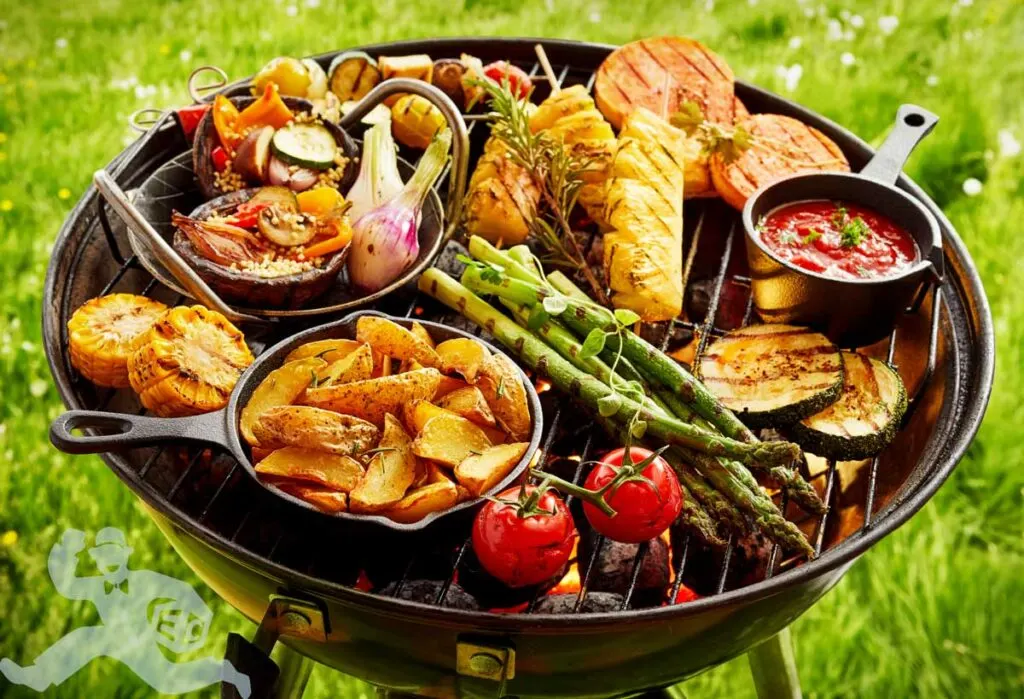The best times to deliver for Doordash are when there are the most delivery offers available for the number of available Dashers.
It’s all about supply and demand.
The beauty of being an independent contractor for gig economy food delivery apps like Doordash is, you get to make your own decisions. No one can tell you when you can and can not get out on the road.
Unfortunately, if you choose the wrong times, you may not make so much.

How do you determine the best times to get out there?
Let’s talk about how to figure that out. We’ll look at when it’s good to Doordash and when it isn’t so great. We’ll discuss
- Why it’s important to pick the best times to Dash.
- Six Important rules to help you decide when it’s good to deliver for Doordash
- The best time of day for Doordash delivery
- Understanding the busier times of the week
- What times of year are busier?
- Paying attention to special events
Why it’s important to pick the best times do Dash
The bottom line is, you’re trading your time for money. Doordash pays on a delivery by delivery basis. Every delivery takes time to complete.
There’s no hourly pay. A Doordash delivery driver has no guarantees or minimum wage. Your time is limited. That makes it valuable.
There are times when there just aren’t many good orders out there. That can leave you sitting waiting for offers, and there are just better things to do with your time.
There are times when Doordash says it’s busy out there, but you’re still waiting and waiting between orders. That’s usually because all the other Dashers got the same notice from Doordash, and now there are more drivers than there are orders.
If you’re going to use up your time to Dash, the best thing you can do is to find the times that allow you to make the most you can make for the time you put into it.
Six Important rules for when it’s good to deliver for Doordash
The thing is, there’s no one answer to when it’s best to deliver. A great time for me to deliver in Denver may not be so great for you wherever you are.
In fact, sometimes you can see real extremes within the same market.
We’ll talk about good times to deliver. But before we do, I think it’s more valuable to understand some basic rules. Those rules help you get better at understanding the nuances within your area and make your own decisions.

Share this Image On Your Site
Click on the text box below to copy the code. Please include attribution to EntreCourier.com1. The more Doordash needs drivers, the higher your earning potential.
There is an art to accepting and rejecting delivery offers from Doordash. While you could take everything that comes your way, that’s a great way to reduce how much you can make.
However, if you’re too picky, you can wait too long between offers and limit your earnings even more.
The trick is to find that balance between identifying the best Doordash deliveries while not pricing yourself out of the market.
When the demand is high, either because Doordash is absolutely swamped or because there aren’t enough drivers, the orders come in more rapidly. If you decline orders like a $2.50 ten mile special, the next offer is going to come in almost immediately.
What that means is, the busier you are, the choosier you can become. You can get by with an incredibly low acceptance rate when you’re getting several offers per minute. If there are longer waits between offers, the cost of your lost time waiting on better offers can be greater than the benefit.
When you can be choosier, you can make more in the time you deliver, and you can also better limit the miles you have to drive. That can be huge when gas prices are out of control.
2. The number of drivers out there is as important (maybe more) as how many busy Doordash is.
Doordash can be extremely busy in your area. However, if they have too many drivers in your zone, you can find that your order frequency is much lower in peak times than in what normally are slower times.
At the same time, if the food delivery service isn’t as busy but there also aren’t many drivers out there, you might find the Dasher app is chiming off the hook.

A lot of Dashers call this driver saturation. If there’s more competition for orders, you may have longer waits between offers. As we mentioned above, you may have to be less selective and ultimately, the ceiling for what you can make gets a lot lower.
You’ll notice that Doordash schedules Dashers and limits the number of drivers that can log in to a given zone at a given time. That would be great, but then they offer a benefit called Top Dasher where drivers who meet certain qualifications can deliver at any time regardless of restrictions. It’s a great way for Doordash to get drivers to do what they want them to do, but the flip side it adds to the saturation problem.
3. Pick times when customers are paying more.
The busiest time may not always be better than slower periods, if pay per delivery is lower.
Prior to the pandemic, dinner deliveries were more frequent than lunchtime. However, with many people working from home, the volume of lunchtime deliveries took off.
I’ve heard a lot of people say that lunch was now a better time to deliver than the dinner rush. However, my experience has been that dinner was still better because the average Dasher payouts were better.
When customer tips are often based on the order amount, that means those larger or higher value Doordash orders will pay better.
This is why pay cycles are often important. It’s one reason new orders shot up after stimulus money was sent out. When people have money, they order out more. If they have more disposable income, they often are more generous with their tips.
Pay attention to when and how people are spending in your market.
4. Understand the vacuum principle.
The vacuum principle is simply that when Doordash (and other food delivery services) start paying more for deliveries in some areas than in others, all the drivers who flock to chase that incentive money create a vacuum in other areas.
This is extremely frequent when one zone has a high peak pay amount. Dashers chase the peak pay, and suddenly there aren’t enough Doordash drivers in neighboring zones.
So often, what happens is drivers get there only to have to wait a long time for food to be ready.
However, in a neighboring zone, there aren’t enough drivers to meet the demand. This means more offers per minute for Dashers that are there. What that means is, you can be more selective, and often make a lot more money for your time in a lower peak pay zone than in the ones with the higher bonus.

The vacuum principle isn’t just tied to Peak Pay. Some drivers simply chase the hot spots thinking they’ll make money, and you can just stay put, the right place may be to fill the vacuum left in your so-called slower zone, and mop up.
It also happens when other delivery platforms are offering large bonuses. The thing to remember here is that a lot of drivers work multiple applications.
- If Grubhub or Uber Eats are offering huge incentives in your market, that can draw drivers away from Doordash.
- If Uber Eats has high surges in certain parts of town, you may want to deliver for Doordash in that same area OR go fill the vacuum delivering Uber Eats in a nearby zone.
- If Doordash has high peak pay, they may be drawing a lot of drivers away from other food delivery services. That may be the time to fill the vacuum for one of the other companies.
5. Know your area as well as possible.
Knowing the Doordash peak hours or the busiest times isn’t nearly as useful as knowing your own market.
Is your town made up mostly of lunch eaters, or do they order out for dinner more often? When do people tip the most (Rule 3)? Is your market made up more of college students or professionals?
When are things busiest in your area (Rule 1)? What parts of town are saturated (Rules 2 and 4)?
What happens in Denver is very different than in downtown Chicago. And Chicago is going to be a huge difference from some small town in Kentucky.
One thing that made a huge difference for me was when I started tracking deliveries in detail. I tracked every delivery order, kept track of profit per hour for each delivery. I was able to use that to figure out which nights of the week were best for me, what time of day was best, and even what part of town was most profitable to work in.
6. Pick the times that work the best for you.
Start with your why. Why are you delivering for Doordash? Is it because you can set your own hours? Are you a student working around class schedules, or a parent working this as a side hustle around your kid’s activities?
Keep your reasons in perspective. If you choose to be a self-employed independent contractor because you can set your own schedule, but you feel forced to work different times by what others think are the best hours, are you defeating your purpose for Dashing in the first place?
Your best times to deliver are going to be different as a full-time gig worker than if you’re doing this as a side hustle to make more money on Doordash.
While it’s valuable to find the times where you can make the most money possible for the time you put into it, don’t sacrifice the things that are most important in order to do it.
What time of the day is the best to Dash?
As a general rule, you can expect to be busier between 11 and 2 for lunch, and between 5 and 9 for dinner time. Some markets may vary slightly.
If folks in your area tend to eat later in the day, you might shift that back, (or move it up if they tend to eat at earlier times).
Breakfast deliveries and early mornings can be hit or miss. I often get messages that Doordash really needs drivers in my area during breakfast. The delivery map is as red as it can get. But then I get out there and either the vacuum principle has happened, or Doordash has just overestimated the need.
Remember that the right times and how much money you can make all depend as much on how many other Dashers are out there as it does the actual time of day period.
I’ve talked to some drivers who feel that late nights are the best. While not the busiest hours for overall delivery, the fact that not many others want to deliver then means they can make some good money.
There’s another factor that’s as important or more so when evaluating the time of day: When are the higher-paying orders happening? Things could be swamped for breakfast, but if all the breakfast orders are low paying McDonalds deliveries or long waits at IHOP, that may not be so great.
There’s a recurring theme developing here: There’s no time that’s universally the best option. Whether early morning hours, peak delivery times, or doing the night shift is a good idea or not varies so much based on where you are and what the conditions are like.
In other words, the important thing here is that understanding your market will hep you know the best Doordash times.
Pay attention to the busier and slower days of the week.
Again, this is going to vary by market. Typically you will find more order activity happening on weekends, Friday, Saturnday, and Sunday.
Monday and Tuesday tend to be the slowest days for local restaurants, and my experience is that holds true for delivery as well. In fact, I almost always take Tuesdays off. That’s often true of Mondays as well (except maybe during Monday Night Football).
I have to say, I get a kick out of being able to say I have Mondays off. That’s the beauty of being self-employed.
Pay attention to slower and busier times of the year
July and August are often slower than a lot of months. I think there are a number of reasons for this. People are away from home more often. When the weather’s good, they stay home and cook out more often. There’s more a sense of getting out and about during the summer.

If you’re in a college town, students have gone home. My experience with college students is there are a lot of cheaper single meals that don’t pay much. While I usually don’t take those orders, other drivers do. While they’re busy delivering to students, I can pick up the better deliveries.
But when the college kids are gone, there are more of us competing for fewer orders.
Add to the mix that those students may be out delivering to make money.
Historically, September tends to be the slowest month for restaurants. However, in my experience that’s not always been the case for deliveries. Students are back in their dorms, so that leads to an uptick.
My experience has been the start of sports seasons, especially football season, tends to drive a lot of deliveries. I think people order in more for delivery when watching football than with most sports.
You will find that cold, rainy and bad weather often drivers a lot of delivery orders. People don’t go out as much and may be more likely to have food brought to them. In most markets, fall through spring are the busiest delivery times.
Pay attention to special events.
Big events can be a great time to deliver, especially if Doordash customers are more likely to order food at the same time that competing drivers are more likely to stay off the road because of those events.
I mentioned football season earlier. Sundays are a great time to deliver here in Denver because one, people are watching the Broncos, and two, a lot of drivers are staying home to watch the game.
The Super Bowl can be one of the best times to deliver. Other major championships and TV awards nights (such as the Oscars and Grammy’s) can be great times to deliver. Finale nights for popular television series are also big nights for delivery.

Holidays are another big delivery draw. Once again, it’s a double whammy because you have more people ordering and often fewer people delivering.
Doordash put out a list to restaurants of the ten biggest delivery days. Those days include:
- Christmas Day
- New Year’s Day
- Valentine’s Day
- Labor Day
- Mother’s Day
- New Year’s Eve
- Halloween
- Memorial Day
- Father’s Day
- Superbowl Sunday
These may or may not be the best days to deliver. Sometimes they’re a great time to make some extra money because there are a lot of orders and not many competing Dashers.
Other times, market saturation can be terrible because everyone and their dog seems to be out there. One bad delivery on an overly busy night where you’re stuck waiting an hour to get through to Doordash driver care to resolve an issue can kill an otherewise great night.
Your results may vary
That almost sounds like a commercial for an investment or something, doesn’t it? But you know something? It IS an investment.
When is it best to Doordash? Knowing the busy times, days and seasons can help you, but understanding your own market is the best way to really figure it out.
Here’s the deal – if you pay close enough attention, and you have the flexibility to work your drive schedule around the more profitable times to drive, that can make a tremendous difference in how much you earn.


